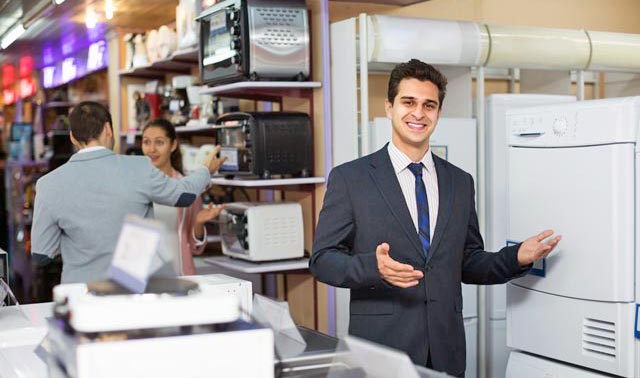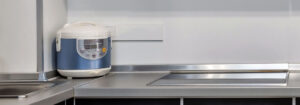An air fryer is a kitchen appliance that cooks food by circulating hot air around it. It’s a popular alternative to deep frying because it produces a crispy layer similar to that achieved by deep frying but uses significantly less oil. Air fryers are versatile and can be used to cook a variety of foods, including vegetables, meats, and even baked goods.
Air fryers are known for their convenience and speed. They typically cook food faster than traditional ovens, and many models come with pre-programmed settings for different types of food. This makes them very popular in kitchens around the world.
How an air fryer typically works?
Air fryers have a heating element at the top of the appliance. This element produces the heat needed to cook the food. Positioned above the heating element is a powerful fan. This fan circulates the hot air around the food at high speed, creating a convection effect.
The food is placed in a basket or on a tray within the air fryer. This basket or tray allows the hot air to circulate around the food evenly. The rapid circulation of hot air cooks the food and creates a crispy outer layer.
Guidance on air fryer safety
Air fryers are generally considered safe to use, but like any kitchen appliance, it’s important to follow proper safety guidelines to minimise risks.
Air fryers can become very hot during operation, especially the heating element and the outer surfaces. It’s important to use caution and avoid touching these hot parts during and immediately after cooking. Most air fryers have heat-resistant handles and features to prevent accidental burns.
Some air fryers release steam during cooking. When opening the basket or tray, be cautious of the hot steam that may escape. Ensure that the air fryer is placed in a well-ventilated area to allow proper air circulation.
As with any appliance, understanding and following the manufacturer’s instructions and practicing common-sense safety measures can help ensure a safe cooking experience.
Are air fried foods healthy?
Air-fried foods are generally considered healthier than their deep-fried counterparts because air fryers use significantly less oil to achieve a crispy texture. Traditional deep-frying involves submerging food in large amounts of oil, which can significantly increase the fat content of the food.
Frying food at high temperatures can lead to the formation of certain potentially harmful compounds, and acrylamide is one of them. Acrylamide is a chemical that can form in certain foods when they are cooked at high temperatures, such as deep frying, baking, or roasting.
Air fryers, by design, can help reduce the risk of acrylamide formation compared to traditional deep frying methods. It’s important to note that the complete elimination of acrylamide is challenging because this compound is a natural by-product of the reaction, which occurs when certain foods are cooked at high temperatures.
While air fryers can contribute to a healthier cooking approach with potentially lower acrylamide formation, a well-rounded and balanced diet, along with varied cooking methods, is always advisable for overall health.
Additionally, the shorter cooking times and lower temperatures used in air frying may help retain more of the natural nutrients in the food compared to deep frying, which can expose food to high temperatures for longer periods.
However, it’s important to note a few considerations:
- While air frying reduces the overall fat content, the healthiness of the final dish still depends on the choices of ingredients.
- While air-fried foods are generally lower in calories than deep-fried foods, they still contribute to your overall calorie intake.
- While air frying can be a healthier cooking method, it’s just one component of a balanced diet.
What can you not put in an air fryer?
While air fryers are versatile kitchen appliances, there are certain foods and materials that are not suitable for cooking in an air fryer. Here are some items you generally shouldn’t cook in an air fryer:
- Foods with loose or wet batters might not fare well in an air fryer. The batter could be blown away by the circulating air, leading to uneven coating or a messy result.
- Foods with high water content, like fruits or watery vegetables, might not work well in an air fryer. The hot air circulation can cause these foods to become too dry.
- While air fryers can cook smaller cuts of meat quite well, very large cuts or whole roasts may not cook evenly.
- Foods with excessive liquid or sauce may not be suitable for air frying. The excess liquid can drip into the bottom of the air fryer, potentially causing smoking or other issues.
Always refer to your specific air fryer’s user manual for guidance on what foods are suitable for your particular model.
Is an air fryer actually worth it?
The decision to get an air fryer depends on your cooking preferences, lifestyle, and the types of foods you enjoy.
If you’re looking for a healthier way to prepare fried foods with less oil, an air fryer can be a good choice. Additionally, air fryers generally use less energy than traditional ovens, making them a more energy-efficient option for certain cooking tasks. It’s always a good idea to check for the latest reviews and information if you’re considering purchasing an air fryer.
If you rarely fry foods or are satisfied with your current cooking methods, an air fryer might not be necessary.








